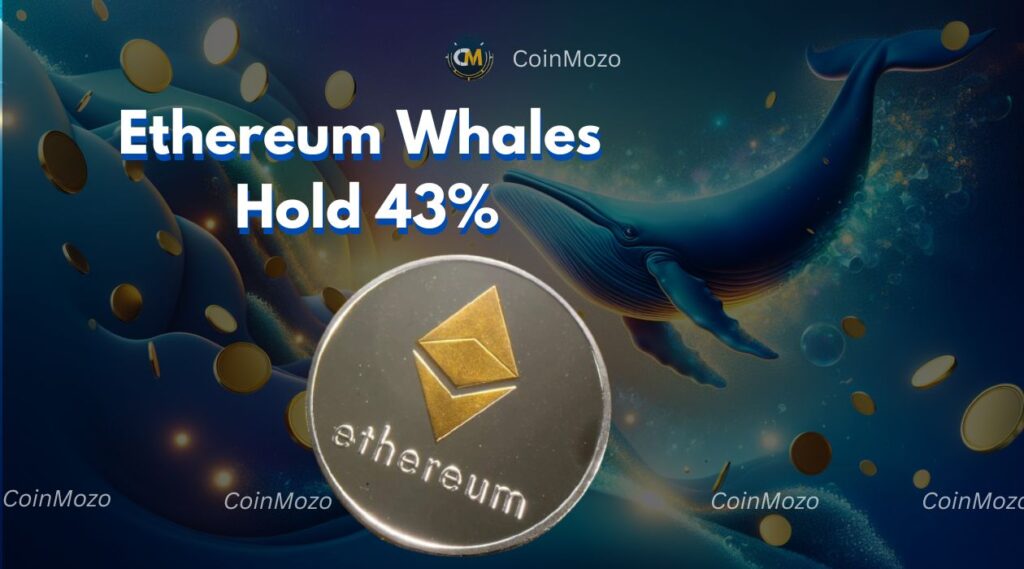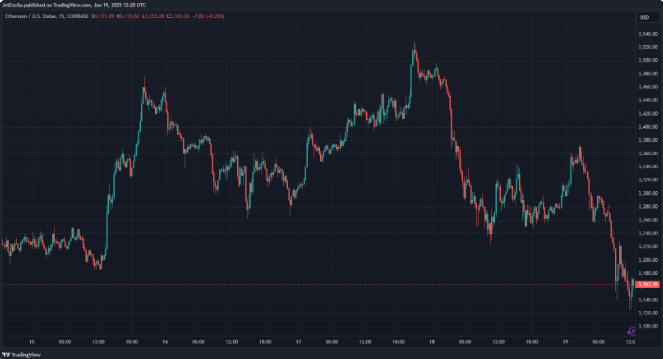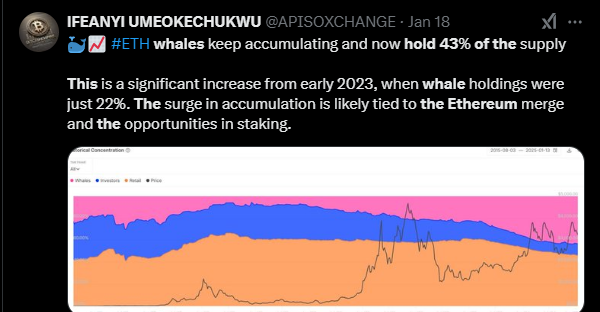Ethereum whales now make up 43% of the market. This outcome may bear impacts on price stability and retail trader market dynamics.
Ethereum whales currently hold 43% of the total circulating supply of Ethereum (ETH), which has more than doubled from 22% in early 2023. Rising ETH accumulation by whales is a good indication for retail traders as now less of the ETH is left circulating among them. A change in supply dynamics can be challenging for the price of Ethereum and behavior in the market, especially if investor addresses decide to sell off their entire holdings. This overview discusses what the change means for retail traders and the Ethereum market.

Who Are Ethereum Whales and How Much Do They Hold?
Over the past year, large holders of Ethereum have been accumulating large stocks of them. As the blockchain analytics firm IntoTheBlock has reported, control by Ethereum whales now makes up about 43% of the total circulating supply of ETH. Their control began rising from 22% in early 2023. Whale addresses—those holding more than 1% of the total circulating supply—now hold 61.09 million ETH, an enormous concentration of the currency.
Ethereum whales: This surge is largely influenced by two aspects, which include Ethereum’s merger that took place in 2022 and ETH staking which has become quite the phenomenon of the time. This merge marked Ethereum as one moving from the PoW system to PoS. Subsequently, big holders had been prompted to keep their ETH stashed away for staking procedures. It further decreases the number of coins being circulated, therefore indirectly helping Ethereum climb the price scale.

Impact on Market in Ethereum Whales Accumulation
Ethereum whales: The increasing concentration of Ethereum in the wallets of large whales raises an important question in terms of further price dynamics in the cryptocurrency. Very few addresses with large chunks of ETH negatively affect Ethereum’s price. Such concentration in most scenarios leads to price manipulation as whales have excessive influence in the market. In the case of Ethereum, such risks have been minimized due to changes in its system and recent structures that have made its ecosystem unique.
This means whales currently hold 43% of the control amount of ETH that other traders have access to. The Ethereum proof-of-stake system locks up a considerable portion of the ETH, meaning it is relatively less liquid and accessible for trade. The market relies more on small investors and retail traders who make price moves.
What does this mean for retail traders?
More Ethereum whales-controlled ETH is accumulated, which means less Ethereum on the blockchain for retail traders to buy. Existing large holders locking up their ETH in staking protocols have reduced the circulation supply for Ethereum. This could make it even harder for retail traders to get ETH at the price points they want.
Currently, the ETH circulating supply is owned by less than 0.1% of retail traders. While this represents a large number of individual addresses, it becomes evident that investors and whales command the power to move the market. Investors and smaller addresses possess the remaining 46% circulating supply of ETH.
If these investor addresses decide to sell off their holdings, then this would trigger price fluctuations that will be against retail traders seeking stability. Latest statistics have placed Ethereum trading at $3,225, but the large selloff by investors could lead to a drop in price.
Impact of Investor and Retail Addresses
Ethereum whales: IntoTheBlock, based on circulating supply, categorizes the addresses as having between 0.1 percent and 1 percent as investors. These would hold around 15.2 million ETHs or 10.77% of the circulating supply. As for retail, the number is abundant but amounts to a small percentage of the circulating supply; this means they own less market movement.
Investors, however, hold more liquid portions of ETH, thus making it easy for them to influence the price of Ethereum. A high selloff among investors may lead to a disastrous decline in the price of Ethereum, a situation a retail trader is not looking forward to.

For the latest updates about cryptocurrency news, visit Coin Mozo on X.
Conclusion: The concentration of Ethereum in the hands of whales and large investors means that retail traders need to be cautious. With 43% of the total supply controlled by a small group of addresses, retail traders could face difficulty acquiring ETH at favorable prices. Though the ecosystem of Ethereum is designed to reduce the risks of price manipulation, the market remains heavily influenced by large holders.
A retail trader needs to follow the movement of Ethereum supply dynamics. Whale accumulation is growing, and there’s further growing interest in ETH staking, so it’s providing a new face to the market. So, retail traders need to keep track of investor activity because any significant selloff can cause volatility in the price of Ethereum. It’s a shift in the balance of power and, therefore, retail traders have to realize how it’s going to change their investment strategy.
Also Read: Solana Price Surges 15% On Rumors of U.S. Strategic Digital Reserve Announcement
